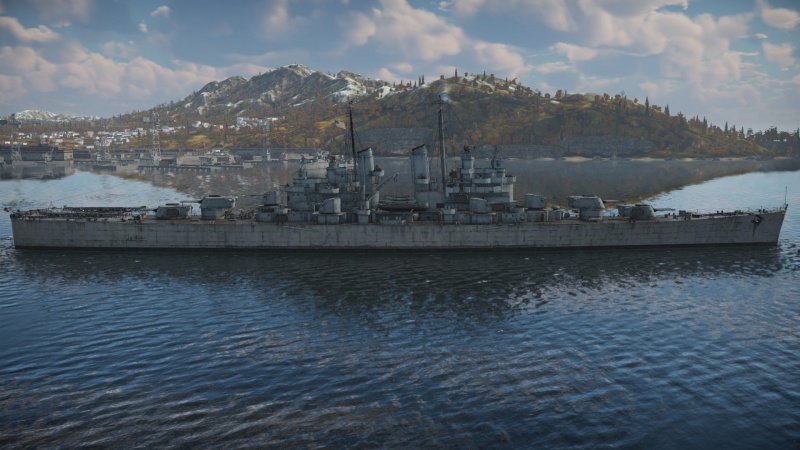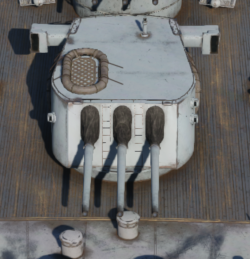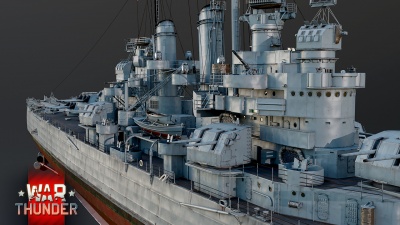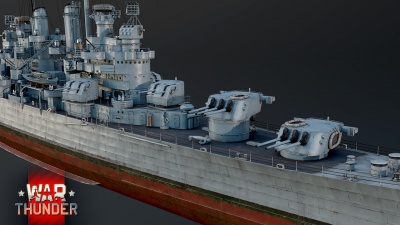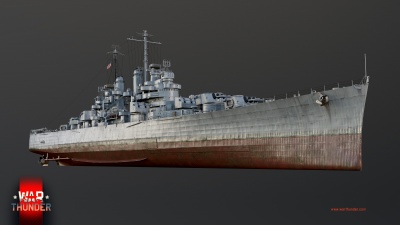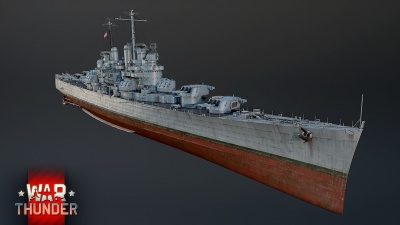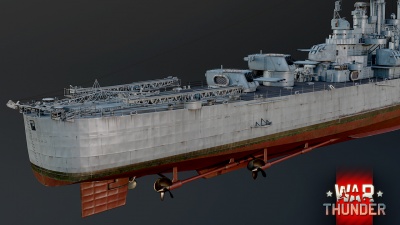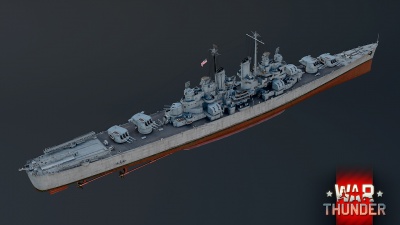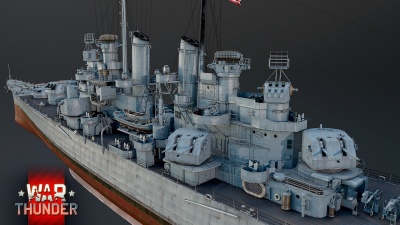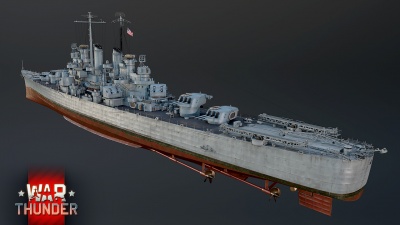Difference between revisions of "USS Cleveland"
m |
(Added more comprehensive protection table) (Tag: Visual edit) |
||
| Line 16: | Line 16: | ||
Overall the Cleveland is well armored for a cruiser, and if angled has the resilience needed to battle multiple enemies simultaneously for a long period of time. | Overall the Cleveland is well armored for a cruiser, and if angled has the resilience needed to battle multiple enemies simultaneously for a long period of time. | ||
| + | |||
| + | {| class="wikitable" | ||
| + | !Armour | ||
| + | !Front | ||
| + | !Side | ||
| + | !Rear | ||
| + | !Deck/Roof | ||
| + | |- | ||
| + | |Turret | ||
| + | |165 mm | ||
| + | |76 mm | ||
| + | |38 mm | ||
| + | |76.2 mm | ||
| + | |- | ||
| + | |Magazine (Front) | ||
| + | |127 mm | ||
| + | |50.8 mm | ||
| + | |N/A | ||
| + | |50.8 mm | ||
| + | |- | ||
| + | |Citadel | ||
| + | |95.25 mm | ||
| + | |127 mm (upper belt) | ||
| + | 82.55 (lower belt) | ||
| + | |95.25 mm | ||
| + | |50.8 mm | ||
| + | |- | ||
| + | |Magazine (Rear) | ||
| + | |N/A | ||
| + | |119.4 mm (upper) | ||
| + | 76.2 (lower) | ||
| + | |127 mm | ||
| + | |50.8 mm | ||
| + | |- | ||
| + | |Barbette | ||
| + | | colspan="3" |152.4 mm | ||
| + | |N/A | ||
| + | |- | ||
| + | |Bridge | ||
| + | | colspan="3" |152 mm | ||
| + | |N/A | ||
| + | |} | ||
=== Mobility === | === Mobility === | ||
Revision as of 23:54, 22 June 2022
Contents
Description
The Cleveland-class, USS Cleveland (CL-55), 1942 is a rank American light cruiser with a battle rating of (AB), (RB), and (SB). It was introduced in Update "Starfighters".
General info
Survivability and armour
The Cleveland is exceptionally well armored, with 127 mm protecting the citadel, 165 mm on the turret faces and very strong barbette protection. As a result, it can be very difficult to disable its primary armament. In addition, its secondary armament of 5"/38 cannons is housed in turrets, which although will not stand up to a direct hit will protect them from HE shrapnel, thus making the warship significantly more resilient to destroyer superstructure fire spam than most other cruisers. Although its frontal magazine only has 50 mm of armor protection and no fuel tanks, this is compensated for by the very deep placement of it. In contrast the rear magazine has both good armor and fuel tanks, making it extremely difficult to detonate. The Cleveland is however somewhat prone to fire detonations, so putting them out quickly is a must.
Overall the Cleveland is well armored for a cruiser, and if angled has the resilience needed to battle multiple enemies simultaneously for a long period of time.
| Armour | Front | Side | Rear | Deck/Roof |
|---|---|---|---|---|
| Turret | 165 mm | 76 mm | 38 mm | 76.2 mm |
| Magazine (Front) | 127 mm | 50.8 mm | N/A | 50.8 mm |
| Citadel | 95.25 mm | 127 mm (upper belt)
82.55 (lower belt) |
95.25 mm | 50.8 mm |
| Magazine (Rear) | N/A | 119.4 mm (upper)
76.2 (lower) |
127 mm | 50.8 mm |
| Barbette | 152.4 mm | N/A | ||
| Bridge | 152 mm | N/A | ||
Mobility
| Mobility Characteristics | |||
|---|---|---|---|
| Game Mode | Upgrade Status | Maximum Speed (km/h) | |
| Forward | Reverse | ||
| AB | |||
| Upgraded | |||
| RB/SB | |||
| Upgraded | |||
The USS Cleveland's speed is in line with the rest of the US cruiser lines, and as such is faster than the cruisers of most other nations. This can be used to get to cap points and positions quickly, as well as rotate around the map. The USS Cleveland is also decently agile for a cruiser, allowing it to make quick course adjustments and tight turns whether it is to dodge torpedoes or turn around and retreat.
Modifications and economy
Armament
Primary armament
Cleveland carries a main armament of twelve 6"/47 Mk.16 guns in four triple turrets, two fore and two aft. As the standard main armament of American light cruisers, these guns are very effective anti-ship weapons. The guns are capable of firing at 10 rounds per minute (6-second reload), meaning that they have one of the highest fire rates for any 6 inch cannon (only the German triple 6-inch turrets fire faster at 12 rounds per minute). That means that you can output a crazy 120 six-inch shells per minute! The guns have good firing arcs and good ballistics as well for a gun of its size. However, they have a relatively slow turret traverse speed compared to its contemporaries.
The gun has access to four shell types - Mk.34 HC, Mk.35 AP, Mk. 34 HC with base fuse and Mk.34 HC-VT. Of these, the Mk. 35 AP is typically the best choice against armoured targets (i.e. heavy cruisers and battleships) as it is the only shell with good penetration values. After researching parts and FPE, the AP shell should be the first priority. The Mk.34 HC with base fuse could potentially be used against lighter-armoured cruisers, as it has superior penetration values compared to the original shell. In addition, unlike most HE shells which cause significant flooding but little internal damage, the base fuze of this shell means that the Cleveland can cause insane internal damage to destroyers; even a Porter-class, otherwise quite resilient for a destroyer can have its entire crew wiped out in two or three salvos. Typically, one should take ~50% Mk.35 AP, ~40% Mk. 34 HC with base fuse, and ~10% Mk.34 HC-VT in case you want to attempt to shoot down aircraft with the main guns - however this generally isn't recommended due to the turrets' slow rotation speed. The Mk.34 base fuse is superior to the original Mk.34 HC shell as it has better penetration values but retains the explosive mass.
The end result is a balanced warship that has both the penetration to hit the vitals of enemy cruisers and the DPS to challenge and melt down multiple destroyers and cruisers alike in rapid succession.
Secondary armament
Cleveland is equipped with twelve 5"/38 (12.7 cm) Mark 12 guns mounted in six twin dual-purpose turrets. These guns are extremely effective against surface and air targets alike, and are capable of firing at an obscene 22 rounds per minute while using first-stage ammunition. The weapon also has a very good vertical and horizontal rotation speed, and is capable of engaging aircraft due to its high-angle capability (up to 85 degrees).
Cleveland gets access to the standard three shell types - Mk.34 AAC, Mk.46 Common SP, and Mk.31 AAVT. The SP is typically the best pick for heavier-armoured targets such as cruisers, while the AAC shell works better against unarmored targets due to its large explosive filler. The Mk.31 AAVT is a great option for dealing with air targets due to its proximity fuse - a single direct hit should be enough to destroy an incoming bomber.
Anti-aircraft armament
Cleveland gets access to eight 40 mm Bofors guns in four twin mounts. These weapons are extremely potent anti-aircraft guns due to their accuracy and punching power. Though these weapons fire slower than the 20 mm Oerlikon or 12.7 mm AN-M2, they more than make up for it due to their hard-hitting 40 mm shells. These guns are capable of shredding aircraft and small boats from ranges of 2.5 km away, though effectiveness will drop off after that range due to the large bullet drop. The guns fire from 4-round clips that reload continuously, meaning that they are capable of continuous fire. However, note that they will eventually jam after firing too long.
Cleveland also gets access to 13 single 20 mm Oerlikon mounts. The 20 mm Oerlikon cannon was the standard light anti-aircraft gun for several nations, including the United States, and replaced the prior AN-M2 Browning machine gun. This weapon is an effective short-range AA gun, and has great firing angles. However, note that the weapon is rather ineffective at long ranges, as its 20 mm shells lose velocity pretty fast after ~1.5 km. As well, the guns fire from a drum magazine that will need to be reloaded. Because of the magazine design, the gun will not jam with continuous fire.
Scout plane
Located on the stern are two catapults with one OS2U-1 scout plane each which provide unique offensive and defensive abilities, expanding tactical options. Ship-launched scout planes fly just like regular tree units but lack munition choices and cockpit views. Alongside the typical abilities of strafing, dropping 2 x 100 lb bombs, and capping zones, the OS2U-1 and other scout planes have the added ability to lay down smoke cover (up to 3 times). Captains will be wise to remember to utilise the aircraft and consider when best to use it, for example to cap a point early or late in the match, to create a smoke screen to stymie enemy bombardment and repair, to attack enemy units directly, or perhaps something completely new! With two scout planes one can risk a cap attempt at the beginning of the match, saving the second for any opportunity that presents itself.
Usage in battles
USS Cleveland, being the multi role ship that she is, is quite versatile.
AA Boat: Cleveland's remarkable AA battery means she could easily devastate any plane that comes close to her, provided that your 5"/38 calibre guns have HE-VT ammo, otherwise aircraft could easily get into ordnance-dropping range.
Destroyer Hunter: Cleveland's primary armament of 12 x 6 inch guns allows her to get devastating salvos on her enemies, and with her base fuse ammunition she could easily sink an enemy DD with a couple salvos. Her secondary armament of 12 x 5 inch guns allows her to whittle down nearby DDs without you having to use your main guns.
Cruiser Killer: Cleveland's rapid fire main guns with excellent AP ammunition allow her to penetrate enemy light cruisers and some heavy cruiser's armour belts with ease, allowing her to slowly demolish their crew. While not as good at this as the USS Brooklyn (CL-40) or USS Helena (CL-50), she is still exceptional in this role.
It should be noted that the Cleveland's 6 inch guns lose effectiveness at long range, so it is best used as a brawler in relatively shallow or closed waters, using islands to get into close range of enemies before using rapid cannon shots to quickly suppress and sink hostile vessels. In addition, as a consequence of having lower caliber guns and not having torpedos, the Cleveland is utterly hopeless against enemy battlecruisers and battleships. When encountering them, the best course of action is generally to turn tail, smoke up, and run.
Pros and cons
Pros:
- 2 x triple-mount 6 inch and 2 x dual-mount 5 inch cannons can fire straight ahead, allowing decent firepower while only exposing a small silhouette towards the enemy
- Excellent armour
- Devastating AA suite
- Two scout seaplanes
- Does not carry any torpedoes (less external fire hazards!)
Cons:
- Does not carry any torpedoes (cannot deny chokepoints or easily destroy enemy capital ships)
- Gets ammoracked easily when stock
History
The USS Cleveland (CL-55) was the lead ship of her class of light cruisers built for the United States Navy during the Second World War. Designed as a follow-up to the earlier Brooklyn-class light cruisers, the ship carried an improved secondary and anti-aircraft armament layout which was used for most successive American cruiser classes. Cleveland saw extensive service during the Second World War in both the Atlantic and Pacific theatres; she was decommissioned after the war and eventually scrapped in 1960.
Design and development
The Cleveland class was designed as a follow-up to the previous Brooklyn class, with improved anti-aircraft protection, speed and range. After navy simulations found that the Brooklyn's anti-aircraft armament was woefully inadequate for fending off large amounts of enemy aircraft, the Cleveland class's design was modified to carry a heavily-improved anti-aircraft armament. The #3 turret of the Brooklyn was removed to accommodate a larger bridge and superstructure, which housed Cleveland's extensive fire control and radar systems. The secondary and anti-aircraft armament was also completely redesigned, focused on new 40 mm Bofors and 20 mm Oerlikon cannons. The design was so successful that the Cleveland class would become the largest cruiser class ever built during WWII - a total of 52 ships were ordered, and 27 were completed to the Cleveland design. A further 13 ships were ordered under the improved Fargo class, while 9 ships were converted into light aircraft carriers. Cleveland, the lead ship of the class, was laid down on July 1st 1940, and following completion, was commissioned on June 15th 1942.
Cleveland's main armament consisted of twelve 6 inch (152 mm) Mark 16 guns in four triple mounts, two fore and two aft. Her secondary armament was heavily improved, with twelve 5 inch (127 mm) Mk 12 guns in six dual turrets. Compared to the last Brooklyn subclass, the ships gained two more Mk 12 twin mounts as the removed 6-inch turret cleared up a lot of space. The Cleveland was initially armed with four dual Bofors mounts and 13 Oerlikon automatic guns for anti-aircraft defence, but similar to other American cruisers at the time, lacked torpedo armament. Her total crew complement was 1255 officers and men, and she had a maximum speed of 32.5 knots (60 km/h).
Operational history
Following her commissioning in June of 1942, Cleveland was immediately sent to join the Allied naval task force supporting the landings in North Africa. She remained there until November, when she was sent to the Pacific Theatre to support operations there. For most of late 1942 to early 1943, Cleveland was in the Guadalcanal area, where she escorted troop convoys and provided fire support. Later in 1943, she participated in the Battle of Empress Augusta Bay, where her radar-guided gunfire helped sink the Japanese cruiser Sendai.
In 1944, Cleveland participated in the Marinanas operation and later the battle of the Philippine Sea, which resulted in a total defeat for the Japanese naval force. She spent the latter part of 1944 supporting operations in the Philippines, based from Subic bay naval base. In July of 1945, she was sent to Okinawa, and performed patrols off of the east China sea until the Japanese surrender. After the end of the war, Cleveland repatriated allied prisoners, and later embarked on a training cruise that took her from Bermuda to Halifax. In 1947, Cleveland was inactivated, and eventually scrapped in 1960. She earned 13 battle stars for her WWII service.
Devblog
In 1938, the U.S. sought an expansion of its navy, following the increase in geopolitical tensions across the globe at the time. As a result, two new 6,000 ton light cruisers were ordered whose specifications complied with the restrictions applied by the Second London Naval Treaty of 1936. In 1939, this design was revised, having its displacement increased to 8,000 tons and the general layout resembling a more compact Brooklyn-class cruiser.
Initially, plans were made for the construction of around 20 ships of this class. However, with the outbreak of WWII in September 1939, these plans were expanded to 52 ships and the design of the vessel had its displacement significantly increased again, since restrictions from previous treaties were no longer being taken into account. In reality however, 27 Cleveland-class cruisers would actually end up being built, with another 9 being converted into light aircraft carriers of the Independence-class.
USS Cleveland (CL-55), being the lead ship of the class, was laid down in July 1940 and saw completion in June 1942 when she also officially got commissioned into service with the USN. Upon entering service, USS Cleveland's first mission involved providing fire support to allied troops landing in Morocco in October 1942. Shortly after, USS Cleveland set course for the Pacific Theater in December, where the ship would serve until the end of WWII.
Although USS Cleveland took part in many operations during her service career, one of her more notable engagements with the enemy was the Battle of Empress Augusta Bay, where Cleveland among with some of her sister ships, successfully defeated a Japanese task force, bound to attack US forces stationed at Bougainville, during a decisive night battle. During the battle, Cleveland-class cruisers proved the effectiveness of their advanced fire control systems and showcased the class' versatility, dealing large damage to both Japanese surface vessels as well as aircraft.
Following the end of hostilities in 1945, USS Cleveland was briefly part of the Allied occupation force in Japan, before sailing back to the U.S. in December that year. Following a brief overhaul in January, USS Cleveland was decommissioned in June 1946 and put into reserve in 1947. Ultimately, the ship was sold for scrap in February 1960, marking the end of her service career.
Media
- Images
See also
Links to articles on the War Thunder Wiki that you think will be useful for the reader, for example:
- reference to the series of the ship;
- links to approximate analogues of other nations and research trees.
External links
References
- Helgason, G. (1995). USS Cleveland. Retrieved January 26, 2021, from https://uboat.net/allies/warships/ship/2579.html
- Woodford, S. R. (2019, August 27). Cleveland II (CL-55). Retrieved January 26, 2021, from https://www.history.navy.mil/research/histories/ship-histories/danfs/c/cleveland-ii.html
| New York Shipbuilding Corporation | |
|---|---|
| Gun Destroyers (DD) | |
| Porter-class | USS Porter |
| Cruiser, Light (CL) | |
| Cleveland-class | USS Cleveland |
| Fargo-class | USS Fargo |
| Worcester-class | USS Roanoke |
| Large Cruisers (CB) | |
| Alaska-class | USS Alaska |
| Battleships (BB) | |
| Wyoming-class | USS Arkansas |
| USA light cruisers | |
|---|---|
| Omaha-class | USS Detroit · USS Raleigh · USS Trenton |
| Atlanta-class | USS Atlanta |
| Brooklyn-class | USS Brooklyn · USS Helena |
| Cleveland-class | USS Cleveland |
| Fargo-class | USS Fargo |
| Worcester-class | USS Roanoke |



